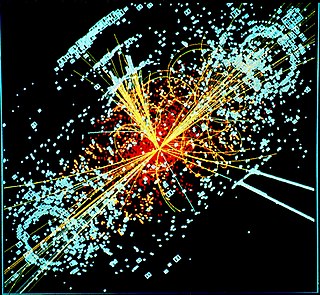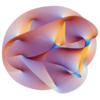In a supersymmetric theory the equations for force and the equations for matter are identical. In theoretical and mathematical physics, any theory with this property has the principle of supersymmetry (SUSY). Dozens of supersymmetric theories exist. Supersymmetry is a spacetime symmetry between two basic classes of particles: bosons, which have an integer-valued spin and follow Bose–Einstein statistics, and fermions, which have a half-integer-valued spin and follow Fermi–Dirac statistics. In supersymmetry, each particle from one class would have an associated particle in the other, known as its superpartner, the spin of which differs by a half-integer. For example, if the electron exists in a supersymmetric theory, then there would be a particle called a "selectron", a bosonic partner of the electron. In the simplest supersymmetry theories, with perfectly "unbroken" supersymmetry, each pair of superpartners would share the same mass and internal quantum numbers besides spin. More complex supersymmetry theories have a spontaneously broken symmetry, allowing superpartners to differ in mass.
String field theory (SFT) is a formalism in string theory in which the dynamics of relativistic strings is reformulated in the language of quantum field theory. This is accomplished at the level of perturbation theory by finding a collection of vertices for joining and splitting strings, as well as string propagators, that give a Feynman diagram-like expansion for string scattering amplitudes. In most string field theories, this expansion is encoded by a classical action found by second-quantizing the free string and adding interaction terms. As is usually the case in second quantization, a classical field configuration of the second-quantized theory is given by a wave function in the original theory. In the case of string field theory, this implies that a classical configuration, usually called the string field, is given by an element of the free string Fock space.

In theoretical physics, supergravity is a modern field theory that combines the principles of supersymmetry and general relativity; this is in contrast to non-gravitational supersymmetric theories such as the Minimal Supersymmetric Standard Model. Supergravity is the gauge theory of local supersymmetry. Since the supersymmetry (SUSY) generators form together with the Poincaré algebra a superalgebra, called the super-Poincaré algebra, supersymmetry as a gauge theory makes gravity arise in a natural way.

Nathan "Nati" Seiberg is an Israeli American theoretical physicist who works on quantum field theory and string theory. He is currently a professor at the Institute for Advanced Study in Princeton, New Jersey, United States.
John Henry Schwarz is an American theoretical physicist. Along with Yoichiro Nambu, Holger Bech Nielsen, Joël Scherk, Gabriele Veneziano, Michael Green, and Leonard Susskind, he is regarded as one of the founders of string theory.
Michael Boris Green is a British physicist and a pioneer of string theory. He is Professor of Theoretical Physics in the School of Physics and Astronomy at Queen Mary University of London, emeritus professor in the Department of Applied Mathematics and Theoretical Physics and a Fellow of Clare Hall, Cambridge. He was Lucasian Professor of Mathematics from 2009 to 2015.
In theoretical physics, type I string theory is one of five consistent supersymmetric string theories in ten dimensions. It is the only one whose strings are unoriented and the only one which contains not only closed strings, but also open strings.
Montonen–Olive duality or electric–magnetic duality is the oldest known example of strong–weak duality or S-duality according to current terminology. It generalizes the electro-magnetic symmetry of Maxwell's equations by stating that magnetic monopoles, which are usually viewed as emergent quasiparticles that are "composite", can in fact be viewed as "elementary" quantized particles with electrons playing the reverse role of "composite" topological solitons; the viewpoints are equivalent and the situation dependent on the duality. It was later proven to hold true when dealing with a N = 4 supersymmetric Yang–Mills theory. It is named after Finnish physicist Claus Montonen and British physicist David Olive after they proposed the idea in their academic paper Magnetic monopoles as gauge particles? where they state:
There should be two "dual equivalent" field formulations of the same theory in which electric (Noether) and magnetic (topological) quantum numbers exchange roles.
In theoretical physics in general and string theory in particular, the Kalb–Ramond field, also known as the Kalb–Ramond B-field or Kalb–Ramond NS–NS B-field, is a quantum field that transforms as a two-form, i.e., an antisymmetric tensor field with two indices.
In mathematical physics, a super Virasoro algebra is an extension of the Virasoro algebra to a Lie superalgebra. There are two extensions with particular importance in superstring theory: the Ramond algebra and the Neveu–Schwarz algebra. Both algebras have N = 1 supersymmetry and an even part given by the Virasoro algebra. They describe the symmetries of a superstring in two different sectors, called the Ramond sector and the Neveu–Schwarz sector.
The history of string theory spans several decades of intense research including two superstring revolutions. Through the combined efforts of many researchers, string theory has developed into a broad and varied subject with connections to quantum gravity, particle and condensed matter physics, cosmology, and pure mathematics.
Superstring theory is an attempt to explain all of the particles and fundamental forces of nature in one theory by modeling them as vibrations of tiny supersymmetric strings.
Warren Siegel is a theoretical physicist specializing in supersymmetric quantum field theory and string theory. He is a professor at the C. N. Yang Institute for Theoretical Physics at Stony Brook University in New York.
André Neveu is a French physicist working on string theory and quantum field theory who coinvented the Neveu–Schwarz algebra and the Gross–Neveu model.
This page is a glossary of terms in string theory, including related areas such as supergravity, supersymmetry, and high energy physics.
Stuart Samuel is a theoretical physicist known for his work on the speed of gravity and for his work with Alan Kostelecký on spontaneous Lorentz violation in string theory, now called the Bumblebee model. He also made significant contributions in field theory and particle physics.
Peter Christopher West, born on 4 December 1951, is a British theoretical physicist at King's College, London and a fellow of the Royal Society.

Lars Elof Gustaf Brink was a Swedish theoretical physicist.
Ramond–Neveu–Schwarz (RNS) formalism was an early attempt to introduce fermions through the means of supersymmetry into string theory. In this theory, worldsheet embedded in spacetime is regarded as a bosonic field and the fermionic fields are regarded as the vectors of spacetime.
Michael Dine is an American theoretical physicist, specializing in elementary particle physics, supersymmetry, string theory, and physics beyond the Standard Model.




